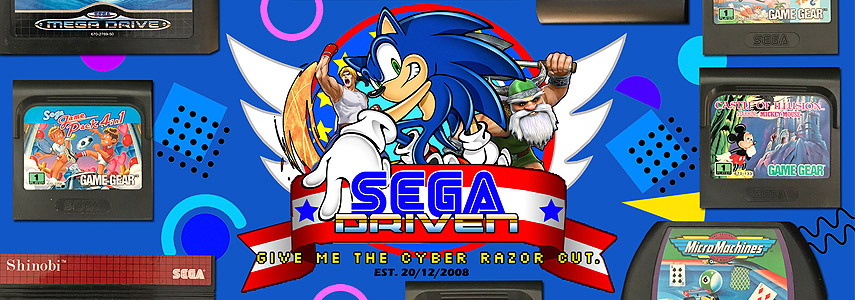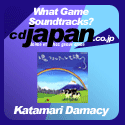SEGA Community Roundtable: Favourite SEGA Platformer That Isn’t a Sonic Game
Castle of Illusion (Master System)

I know what you’re thinking: “The Master System?!? Man, the Mega Drive was where it was AT”. Well, for you, maybe, but I never actually played the Mega Drive version of Castle of Illusion until quite recently. On the flipside, the Master System version remains one of my favourite platformers on that system. To be honest, all the Disney platformers were great, whether it was a movie tie-in like The Lion King or The Jungle Book, or original efforts along the lines of Deep Duck Trouble or The Lucky Dime Caper, but Castle of Illusion just stood head and tails above the rest.
It was a platformer which didn’t conform to the idea that you HAD to have an ice level, and you HAD to have a fire level. Yes, it starts in a forest, and yes you did have swimming sections (albeit in a coffee cup), but the game was content enough to offer levels that you rarely saw. Toy factories, libraries, a clock tower, even a castle (well, I thought castles in SEGA platformers were rare, before Mario fans get up in arms).
Another high point for me was the soundtrack. Although it was just an 8-bit version of the Mega Drive soundtrack, albeit with certain tracks in a different order, it matched the mood of the level brilliantly. In fact, whilst writing this, I’ve got the music for Enchanted Forest stuck in my head, it’s that memorable.
Even if you’ve played the Mega Drive version, I think you should play the Master System version for the completeness of it all. It’s the same, yet it’s different, and with the recent announcement of Epic Mickey 2: Power of Illusion being a direct sequel to Castle of Illusion, is there really a better time? Do it NOW.
Gavin ‘GavvieUK’ Storey
DJ and Webmaster of Radio SEGA
Twitter: @gavvieuk
Rocket Knight Adventures

By far and away, there is a large amount of platformers from the Mega Drive/Genesis of yesturyear, but the game(s) that stand out to me most, is definately Rocket Knight Adventures, and it’s sequel Sparkster: Rocket Knight Adventures 2.
Jumping into the anthropomorphic character fray, which was popular, and a big appeal to the younger market at the time, Konami jumped into the side-scrolling platformer with it’s RKA offering. Now, for those of you old enough, yes there was a version of both RKA and Sparkster on the Mega Drive/Genesis’ rival the SNES, but it was primarily made for the SEGA system, and it’s such a beauty to behold.
The biggest thing that holds this game up above most others, in a non-gameplay way, is the music. For a 16 bit console, the music is utterly amazing, and that’s in both games. Konami did a stella job making a grand use of the hardware at the time.
The platforming elements differ slightly between the two games. Personally, I find the first game has harder sections then the second. An example of this would be the the railcart section, it’s one of the things that didn’t transition between the two games. It was one of the harder sections, with the exception of the last few bosses..
One of my personal favourites that was in RKA, which never made a transition in the same vein to Sparkster, which was the jetpack sections. Basically in Rocket Knight Adventures, these gave you full jetpack power which you then blast through the stage dealing with enemies and progressing through. In Sparkster, these were replaced by a giant Sparkster-looking robot running through the city dealing with the level in the same vein as the jetpack levels.
The boss battles in both games are varying and interesting, unlike some other platformers, none of the bosses use the same mechanics again in the game, so each level has an original boss and mechanic to defeat.
One thing that’s amazing, is the fact that the harder difficulties do offer something extra. On RKA, if you complete the game on Hard or Very Hard difficulty, which on the Jap and EU versions of the cartridge require a code to unlock, gives you an extra final boss to defeat as well as a perfect ending. On Sparkster, playing on Normal or higher, gives you extra levels, and the ability for an extra hidden ending.
What Sparkster offers over Rocket Knight Adventures is a collectable item in the form of legendary blades, and when you collect all of these, which you can only do on Normal or higher difficulties, due to some of these only being hidden on the hidden levels. But collecting all these does give you Golden Sparkster Armour when you collect the last one off your rival Axel Gear.
When it comes to the story, generally, without reading the game manual, the story is explained in a small screen before the game begins, and it roughly is, princess is stolen by Axel Gear, your main rival in both games, and you need to rescue her. It’s a little more detailed in the game manuals, but overall, it remains as mentioned above.
Overall, both games in the Rocket Knight Adventures are amazing platformers in their own right, and if you’ve never played them, you really should give them a go if you can get hold of them. I would also say that not to use the Rocket Knight game from XBLA/PSN as a basis on thoughts from it’s predecessors.
Pete ‘Titanscreed’ Nethercote
Host of The Community Spotlight
Twitter: @titanscreed
ToeJam and Earl in Panic on Funkotron

I’ll be honest. Growing up in the 90’s, I didn’t really know what funk WAS. SEGA taught me the meaning of cool, thanks to a certain blue hedgehog, but my mental image of getting down and funky… Well, that’s been forever shaped by two particular aliens from Funkotron.
ToeJam and Earl in Panic on Funkotron is as far removed from the original Mega Drive classic as you can get. Gone was the top-down treasure hunting madness of old, which was replaced with a rather generic platformer that wasn’t quite as smooth or fast paced as, say, Sonic. But you know what? It was filled with so much FUNK that it simply didn’t matter.
If the music of the Wyld Stallyns could influence a whole future utopia, then I suppose it makes sense that a whole alien society could revolve around funk, and Funkotron is just the coolest place to be, filled with all kinds of wacky aliens to interact with and even wackier humans to capture. And that’s exactly what I loved about the game, the sheer amount of characters and items that could be toyed with, as well as the amount of hidden surprises around every corner.
Oh, and of course, the funk! Both ToeJam and Earl games had a pretty amazing soundtrack, which goes without saying, really.
At the end of each major section, you could “Jam Out” to progress, which was kind of like a memory mini-game with boom-boxes, but funkier, obviously. As well all this random jamming, the ridiculously colourful and trippy levels and those crazy special stage-inspired “Hyper Funk Zones”, the whole game is just crammed full of humour, just like its predecessor. This generally involved a whole lot of tomatoes and burping. Anyone remember the tomato-shooting light gun game for the Menacer? Anyone?
One element of both ToeJam and Earl games that I think SEGA did right is the two-player co-op. My only real experience of two-player co-operative play back then was getting some kid to pilot Tails whilst they whined on at me to slow down, but in Panic on Funkotron, the two-player actually was pretty cooperative, after you finished arguing about who got to play as the cooler ToeJam, anyway. Both player’s could help each other out on screen at the same time, enjoying the leisurely pace of Funkotron whilst hunting down humans and randomly shaking trees so that tyres would fall down and bash each other’s head in.
I never did get the chance to play the third game in the series, which entered the world of 3D gaming on the Xbox, but I do hope we’ll get to see ToeJam and Earl again, in some guise or another. Sadly, SEGA do not own the rights to these two lovable aliens, but perhaps a deal can be made and we’ll get some extra funk injected into All-Stars Racing Transformed. Here’s hoping!
Tru ‘CapnCloudchaser’ Smiles
DJ at Radio SEGA
Twitter: @trusmiles
Dynamite Headdy

Dynamite Headdy was the 3rd game developed by the legendary Treasure, but for me it was the first game I had played by them, that and the Mcdonalds platformer anyway. In fact, it had quite a big impact on my childhood.
I don’t recall when or when exactly I got the game, but I think my first glimpse of it was in the official UK Sega magazine that did a huge feature full of colourful artwork and screens that made it a beg-your-parents-for-it game. As kids me and my sister mainly got brand new Mega Drive games at Christmas and on Birthdays, so each game got a lot of play. There was of course the Sonic and Disney games, as well as some licensed platformers that haven’t aged quite so well, but this one (along with Ristar) really stood out as games that really spun my imagination into overdrive.
I still recall staying over at my grandparents for a week while we were having a kitchen extention built at home, and the only ‘toy’ I took was our Mega Drive and a few games including this one. me and my sister wrote and doodled a Sonic meets Dynamite Headdy comic strip, and I drew comics of Headdy a few other times too, one crossover him over with Mario for some reason.
Anyway enough about my childhood memories of it, let’s talk about the game itself. This was long before I caught up with Treasures most well known classics like Gunstar Heroes, but the distinctive fast, slick and action packed gameplay that is a Treasure trademark is very strong here. It is also quite a tough game, which I have to admit I have never beaten in all these years legitimately, only through a level select cheat as the game is quite a long one to play in one sitting and from a recent play through it appears I don’t have the reflexes from some of the later bosses nowadays.
One thing that really makes this game special is the art style and atmosphere, there really is nothing quite like it. Very few games have gone for a puppet/stage theme (with only the recent Kinect game Gunstringer coming to mind, though I could be wrong) and this game runs with it at full tilt. Platforms are held up by rope, moving parts of the stage are being powered with little muscle men working machinery, and skies are nothing more than cardboard backdrops held up and pushed around by staff. There is so much attention to detail it’s hard to spot it all in one sitting, especially with the fast pace of the game.
The bosses, which are a majority of the game, are simply genius and no two of them are alike. Many have obvious weak points but are a spectacular display of both Treasure getting the most out of the Mega Drive hardware and clever design. Inbetween the bosses are platform stages that also mix things up with new gimmicks in almost every stage, and there are even scrolling shoot ’em up stages.
Dynamite Headdy is not a rare game by any means so finding an original cart shouldn’t be too difficult, unless you are after the Japanese version which is quite pricey. The Japanese version, much like Ristar has quite a few visual differences. The characters have dialogue in the Japanese version for example and some of the bosses look less like giant robots and more like china dolls.
There is also a Game Gear version of the game which is a shockingly good down-port that is also worth checking out. The 16-bit version is also on the Ultimate Mega Drive/Genesis Collection, where it was probably ignored by most gamers as it was one of the few games on the collection without trophies/achievements, bah! However you go about it you owe yourself to check it out as it’s something of an unrated classic.
Aaron “The Gagaman” Foster
Writer at The Dreamcast Junkyard and SEGA Memories
Twitter: @thegagaman
Earthworm Jim

I sit down and run through Earthworm Jim at least a couple of times a year. It’s a game I get endless enjoyment from because there simply hasn’t been anything like it since its’ release in 1994. Dave Perry and Douglas TenNapel’s platformer is one of a kind and something everyone who has any interest in the genre should experience.
Marrying the slapstick, cartoon weirdness of the nineties (made famous by cartoons like Ren and Stimpy) with a video game has been tried and tested in the past with varying results, but Earthworm Jim does it with some fantastically smooth and stylish animation that still holds up really well even to this day. The greatest thing about it is that the graphics don’t hide a rubbish game; they compliment a great game. Earthworm Jim is full of beautiful platforming moments that include bounding up mountains of scrapped tires, fast-paced running sections featuring falling rocks, riding giant hamsters who gobble up overpowered enemies and much, much more.
There’s also a brilliant plethora of hidden extras like holding down while hanging off an edge to see Jim scratch his bum, watching Jim’s vast array of waiting animations (my favourite is when he accidentally shoots himself in the face) and the brilliant ‘Who Turned Out The Lights?’ stage hidden in Level 5.
Let’s take a moment to talk about ‘Who Turned Out The Lights?’ because it marks a clever little twist in the game where the graphics actually change the gameplay. Hindered by a lack of light, you must use Jim’s (and his enemies’) eyes to figure out where you are. It culminates in a brilliant chase from an enormous, unseen enemy (apart from, once again, its’ eyes) and makes for one of the most interesting and unique secret stages a video game has ever seen. I love this stage and it’s probably the highlight of playing Earthworm Jim for me.
Like I’ve said, if you’re a platforming fan then you owe it to yourself to play Earthworm Jim. It’s funny, stylish and contains some of the most unique gameplay you’ll ever get from this genre. If you have access to a Mega-CD you should try and hunt down a copy of the marvellous special edition which contains a password save system, altered stage layouts and entirely new ones that improve the game even further. Groovy!
Lewis “Sonic Yoda” Clark
Webmaster of SEGADriven
Twitter: @segadriven








